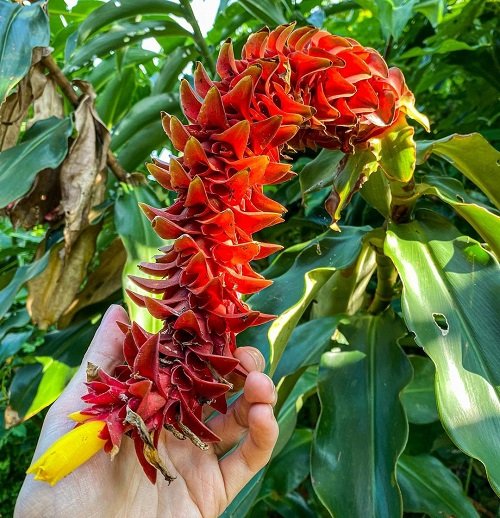Costus Barbatus can be a fantastic garden addition, thanks to its fiery red flowers! Here are all the details about growing it.

Costus barbatus, commonly known as Red Tower Ginger or Spiral Ginger, is a tropical perennial plant that is native to Central and South America. It produces vibrant red bracts that enclose the actual flowers, giving them a unique and attractive appearance.
Learn to Grow Many Ginger Plants from One Ginger
Costus Barbatus Plant Information

Costus barbatus is native to Central and South America, specifically regions such as Brazil, Colombia, Ecuador, Peru, and Venezuela. It is often found growing in the understory of tropical rainforests.
The plant typically grows to a height of 6 to 10 feet (1.8 to 3 meters), although it can reach up to 15 feet (4.5 meters) under optimal conditions. Costus barbatus has an upright growth habit with multiple stems emerging from a central clump. The stems are often thick and sturdy.
The leaves of Costus barbatus are large, elongated, and lance-shaped. They have a deep green color and prominent parallel veins running along their length. The leaves grow in an alternating pattern along the stems.
One of the most notable features of Costus barbatus is its showy inflorescence. It produces vibrant, red bracts that surround the actual flowers. The bracts are arranged in a spiral or helical pattern, resembling a tower or cone. The actual flowers are small and often hidden within the bracts.
Costus barbatus typically blooms during the warm months, from late summer to fall. The colorful bracts and flowers can persist for several weeks, providing an eye-catching display.
Here is our Geogenanthus Ciliatus Care and Growing Guide
Propagating Costus Barbatus
In contrast to true gingers, Costus can be propagated through rooted cuttings. During the warm months of the year, you can easily propagate Costus barbatus.
- Timing: The best time to propagate Costus barbatus is in the spring or early summer when the plant is actively growing.
- Carefully dig up the parent plant, being cautious not to damage the rhizomes. Gently shake off excess soil to expose the rhizomes.
- Using a clean and sharp gardening tool, divide the rhizomes into smaller sections. Each section should have at least one healthy shoot and a portion of the rhizome attached. Aim for divisions with a good root system.
- Plant each divided section in the prepared soil, making sure the shoots are positioned upright, and the rhizome is partially buried in the soil. Space the divisions adequately to allow for their growth.
- Water the newly planted divisions thoroughly to ensure the soil is evenly moist. However, avoid overwatering as excessively wet conditions can lead to rot.
- Place the newly propagated Costus barbatus in a location that receives partial shade or filtered sunlight. The propagated divisions should take root and start growing within a few weeks.
Propagate Any Plant Cutting Quickly Using this Trick
Requirements for Growing Costus Barbatus

Location
Costus barbatus is adaptable to various lighting conditions, but it thrives best in environments with partial shade. For best growth, you can expose it to 2-3 hours of direct morning sunlight – it will be great for its flowers!
Soil
The ideal soil for Costus barbatus should be well-draining and fertile. It should have a slightly acidic to neutral pH range of 6.0 to 7.5.
Learn How to Check Your Soil pH at Home here
Add perlite or pumice to the soil mix to enhance drainage and prevent waterlogging. Aim for around 20-30% perlite or pumice by volume in the soil mix.
Water
Costus barbatus requires regular watering to keep the soil consistently moist but not waterlogged. It is important to allow the topsoil to dry out slightly between watering sessions.
Avoid overwatering as it can lead to root rot, while underwatering can cause stress and hinder growth.
Here is How to Treat Root Rot in Houseplants Like a Pro
Temperature
To ensure optimal growth of this tropical plant, it is recommended to maintain temperatures between 75 F and 90 F(25-32 C).
However, extreme temperatures outside of 50 F (10 C) or 95 F (35 C) can impede growth and lead to abnormalities in leaves and stems.
Humidity
While it can tolerate average humidity, providing higher humidity levels can promote better growth and overall health. Mist the leaves of the Costus barbatus regularly with room-temperature water.
Use a spray bottle to create a fine mist, ensuring to cover both sides of the leaves. This helps increase humidity and also keeps the foliage clean.
Here are 10 Ways To Increase Humidity For Houseplants That Work
Costus Barbatus Care

Fertilizer
For optimal growth of Costus barbatus, use a balanced, slow-release fertilizer, such as 10-10-10 or 14-14-14. Begin fertilizing in the spring, as new growth emerges, and continue throughout the growing season until late summer or early fall.
Avoid fertilizing during the dormant period in winter.
Here are Effective Homemade Lawn Fertilizers That Are Safe From Hazardous Chemicals
Pests and Diseases
Some common pests that may affect Costus barbatus include aphids, mealybugs, and spider mites. Insecticidal soap, neem oil, or horticultural oil can be used to control them.
One of the common diseases that can afflict Costus barbatus is a fungal infection. Fungi, such as Fusarium and Phytophthora species, can invade the plant’s roots, stems, or leaves, causing wilting, yellowing, and ultimately death of the affected parts. Avoid overwatering, and make sure it gets plenty of air circulation.

